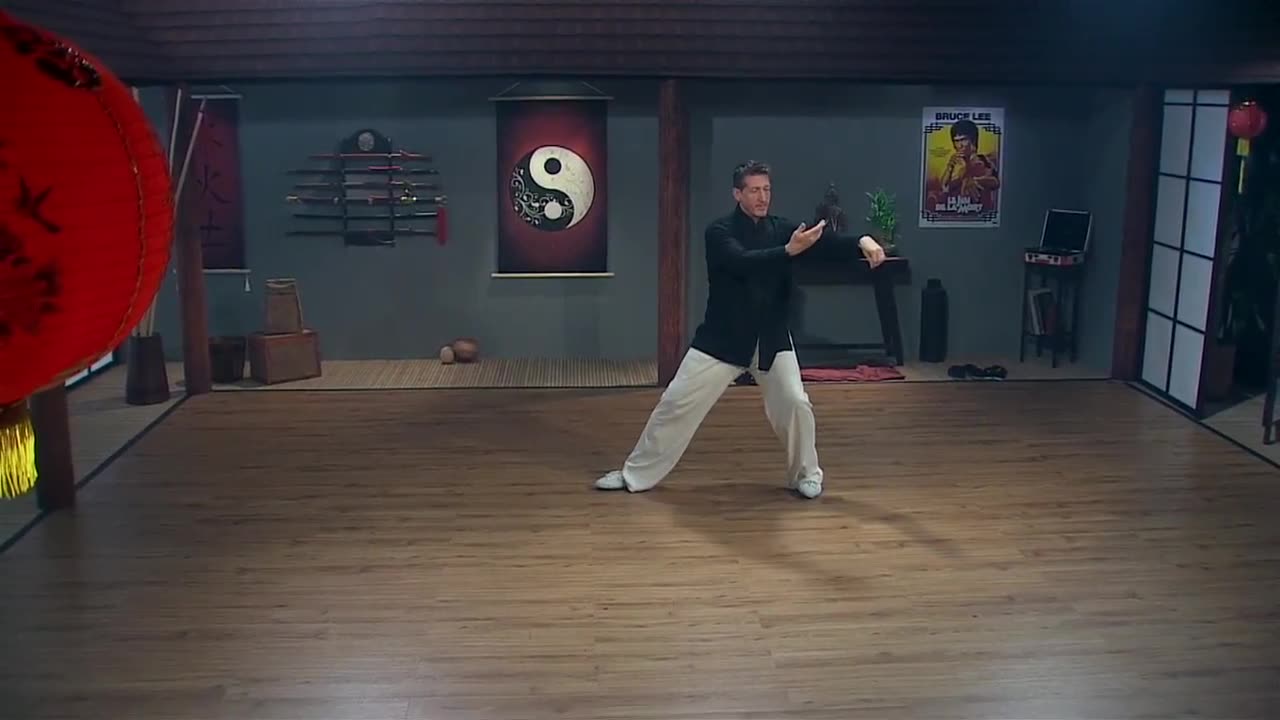Premium Only Content

19. Qigong Breathing
This lecture contains a review of the moves we’ve learned so far. The
progression is getting pretty long, so we’ll take a break from introducing
any new moves. Instead, we’ll go over some aspects of breathing that you
can incorporate into meditation and tai chi practice. We’ll also go over a
brief exercise from qigong.
The Sequence So Far
● Here are the moves we’ve learned to far, in order:
1. Commencing form
2. Grasp the bird’s tail
3. Single whip
4. Step up and raise hands
5. White crane spreads wings
6. Brush knee and twist step
7. Right hand strums the pipa
8. Sealing and closing
9. Parry and punch
10. Diagonal flying
11. Punch under elbow
12. Repulse the monkey
13. Fair lady works at the shuttles
14. Part the horse’s mane on both sides
15. Cloud hands
16. Single whip
17. High pat on horse
18. Kick with right heel
19. Box both ears
20. Separate left foot
21. Turn body and kick with heel
22. Needle at the bottom of the sea
23. Push through the back
24. Snake sticks out its tongue
25. Slap right foot
26. Riding the tiger
27. Snake creeps down
28. Rooster stands on one leg (both sides)
29. Punch groin
30. Grasp the bird’s tail
Meditation Breathing
● Our breathing should have four key characteristics: It should be
deep, long, gentle, and continuous.
● Deep breath means it feels like you are breathing down low in the
belly, rather than up high in the chest. Try this: Put your hands
on your belly below your navel. Now inhale; you should feel your
belly expand and fill into your palms. Exhale, and you will feel the
belly relax and contract somewhat. Once you find it, try to keep the
breath down low.
● Long breath means you can actually count out how long it takes
to breath. Let’s try: First of all, exhale completely. Now inhale,
counting to 5. Now exhale, counting to 6.
● Gentle breath allows us to breathe in longer, rather than filling the
lungs up all at once. Sometimes we call this sipping the breath
rather than gulping it.
● Continuous breath means you shouldn’t hold your breath,
although you will probably discover that in between the inhalation and exhalation there is a relaxed place where you don’t yet
need to breathe. However, that space is not the same as holding
your breath.
Standing like a Tree
● Now let’s do a short sample of an exercise borrowed from qigong,
known as standing like a tree.
● Stand with your feet about shoulder width apart. Soften your hips
and knees just a little bit and sink down into the ground. At the
same time, keep your head feeling light and alert.
● Now raise your arms up and round them out like you’re hugging a
big tree. Hold them there, and imagine a ring of light that encircles
your body, passing through your arms and around your back.
● Next, let that image fade away, and just tune into your breath. Feel
it deep down into your belly as you gently inhale and softly exhale.
Count the length of your breath. Do this for a total of 10 breaths.
● You can continue to build this up: If you can get up to 100 breaths,
you’ll be getting a great standing meditation.
-
 31:36
31:36
Mastering Tai Chi
1 year ago24. Another River To Cross
303 -
 LIVE
LIVE
SilverFox
15 hours ago🔴LIVE - ELDEN RING - LEVEL 300 CHALLENGE
240 watching -
 9:20
9:20
Tactical Advisor
21 hours agoNew Shadow 2 Carry | CZ Compact Upgrade (FIRST LOOK)
31.1K17 -
 7:55
7:55
Talk Nerdy Sports - The Ultimate Sports Betting Podcast
3 hours ago4/27/25 - Sunday Service: Vasil’s 10 Holy Locks & PrizePicks Resurrection 💥🧠
16K1 -
 LIVE
LIVE
Pepkilla
2 hours agoSundayzZzZzZz Wins?
108 watching -
 LIVE
LIVE
Mossy
1 hour ago🍃PRE HALO PARTY🍃OBLIVION HARDEST DIFFICULTY🍃COME CHILL🍃420 SESH🍃GAMING🍃REACTIONS🍃MORE????🍃
52 watching -
 18:15
18:15
World2Briggs
11 hours ago $14.83 earned10 Cities That Are Slowly Emptying Like a Sad Party
36.3K25 -
 11:34
11:34
Mrgunsngear
20 hours ago $8.28 earnedSiege Suppressors ROC556 Low Backpressure Silencer Review 🤫
26.1K5 -
 30:57
30:57
Clownfish TV
7 hours agoDisney Drops DEI and Goes PRO-AMERICA?!
33.4K38 -
 17:35
17:35
QNewsPatriot
20 hours ago(4/25/2025) | AUDIO CHAT 166 | SG Sits Down w/ Sovereign Radio Founder Scotty Saks: Vaxx Lawsuits and the #NeverAgain Telethon
40.1K17